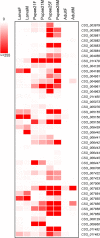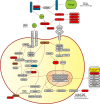Obligate mutualism within a host drives the extreme specialization of a fig wasp genome
- PMID: 24359812
- PMCID: PMC4053974
- DOI: 10.1186/gb-2013-14-12-r141
Obligate mutualism within a host drives the extreme specialization of a fig wasp genome
Abstract
Background: Fig pollinating wasps form obligate symbioses with their fig hosts. This mutualism arose approximately 75 million years ago. Unlike many other intimate symbioses, which involve vertical transmission of symbionts to host offspring, female fig wasps fly great distances to transfer horizontally between hosts. In contrast, male wasps are wingless and cannot disperse. Symbionts that keep intimate contact with their hosts often show genome reduction, but it is not clear if the wide dispersal of female fig wasps will counteract this general tendency. We sequenced the genome of the fig wasp Ceratosolen solmsi to address this question.
Results: The genome size of the fig wasp C. solmsi is typical of insects, but has undergone dramatic reductions of gene families involved in environmental sensing and detoxification. The streamlined chemosensory ability reflects the overwhelming importance of females finding trees of their only host species, Ficus hispida, during their fleeting adult lives. Despite long-distance dispersal, little need exists for detoxification or environmental protection because fig wasps spend nearly all of their lives inside a largely benign host. Analyses of transcriptomes in females and males at four key life stages reveal that the extreme anatomical sexual dimorphism of fig wasps may result from a strong bias in sex-differential gene expression.
Conclusions: Our comparison of the C. solmsi genome with other insects provides new insights into the evolution of obligate mutualism. The draft genome of the fig wasp, and transcriptomic comparisons between both sexes at four different life stages, provide insights into the molecular basis for the extreme anatomical sexual dimorphism of this species.
Figures







Similar articles
-
Interference competition and high temperatures reduce the virulence of fig wasps and stabilize a fig-wasp mutualism.PLoS One. 2009 Nov 12;4(11):e7802. doi: 10.1371/journal.pone.0007802. PLoS One. 2009. PMID: 19915668 Free PMC article.
-
Expression and evolutionary divergence of the non-conventional olfactory receptor in four species of fig wasp associated with one species of fig.BMC Evol Biol. 2009 Feb 20;9:43. doi: 10.1186/1471-2148-9-43. BMC Evol Biol. 2009. PMID: 19232102 Free PMC article.
-
Deep mtDNA divergences indicate cryptic species in a fig-pollinating wasp.BMC Evol Biol. 2006 Oct 13;6:83. doi: 10.1186/1471-2148-6-83. BMC Evol Biol. 2006. PMID: 17040562 Free PMC article.
-
Critical review of host specificity and its coevolutionary implications in the fig/fig-wasp mutualism.Proc Natl Acad Sci U S A. 2005 May 3;102 Suppl 1(Suppl 1):6558-65. doi: 10.1073/pnas.0501840102. Epub 2005 Apr 25. Proc Natl Acad Sci U S A. 2005. PMID: 15851680 Free PMC article. Review.
-
Asymmetric or diffusive co-evolution generates meta-populations in fig-fig wasp mutualisms.Sci China Life Sci. 2014 Jun;57(6):596-602. doi: 10.1007/s11427-014-4653-y. Epub 2014 May 15. Sci China Life Sci. 2014. PMID: 24829105 Review.
Cited by
-
Evolution of five environmentally responsive gene families in a pine-feeding sawfly, Neodiprion lecontei (Hymenoptera: Diprionidae).Ecol Evol. 2023 Oct 1;13(10):e10506. doi: 10.1002/ece3.10506. eCollection 2023 Oct. Ecol Evol. 2023. PMID: 37791292 Free PMC article.
-
Chemoreceptor Diversity in Apoid Wasps and Its Reduction during the Evolution of the Pollen-Collecting Lifestyle of Bees (Hymenoptera: Apoidea).Genome Biol Evol. 2021 Mar 1;13(3):evaa269. doi: 10.1093/gbe/evaa269. Genome Biol Evol. 2021. PMID: 33484563 Free PMC article.
-
Genomic signatures associated with the evolutionary loss of egg yolk in parasitoid wasps.Proc Natl Acad Sci U S A. 2025 Apr 22;122(16):e2422292122. doi: 10.1073/pnas.2422292122. Epub 2025 Apr 15. Proc Natl Acad Sci U S A. 2025. PMID: 40232796
-
The genomes of two key bumblebee species with primitive eusocial organization.Genome Biol. 2015 Apr 24;16(1):76. doi: 10.1186/s13059-015-0623-3. Genome Biol. 2015. PMID: 25908251 Free PMC article.
-
Extreme specificity in obligate mutualism-A role for competition?Ecol Evol. 2024 Jun 21;14(6):e11628. doi: 10.1002/ece3.11628. eCollection 2024 Jun. Ecol Evol. 2024. PMID: 38911491 Free PMC article.
References
-
- You M, Yue Z, He W, Yang X, Yang G, Xie M, Zhan D, Baxter SW, Vasseur L, Gurr GM, Douglas CJ, Bai J, Wang P, Cui K, Huang S, Li X, Zhou Q, Wu Z, Chen Q, Liu C, Wang B, Li X, Xu X, Lu C, Hu M, Davey JW, Smith SM, Chen M, Xia X, Tang W. et al.A heterozygous moth genome provides insights into herbivory and detoxification. Nat Genet. 2013;14:220–225. doi: 10.1038/ng.2524. - DOI - PubMed
-
- Cruaud A, Rønsted N, Chantarasuwan B, Chou LS, Clement WL, Couloux A, Cousins B, Genson G, Harrison RD, Hanson PE, Hossaert-Mckey M, Jabbour-Zahab R, Jousselin E, Kerdelhue C, Kjellberg F, Lopez-Vaamonde C, Peebles J, Peng YQ, Pereira RAS, Schramm T, Ubaidillah R, VanNoort S, Weiblen GD, Yang DR, Yodpinyanee A, Libeskind-Hadas R, Cook JM, Rasplus JY, Savolainen V. An extreme case of plant–insect codiversification: figs and fig-pollinating wasps. Syst Biol. 2012;14:1029–1047. doi: 10.1093/sysbio/sys068. - DOI - PMC - PubMed
-
- Price PW. Evolutionary Biology of Parasites. Princeton, NJ: Princeton University Press; 1980.
Publication types
MeSH terms
LinkOut - more resources
Full Text Sources
Other Literature Sources

